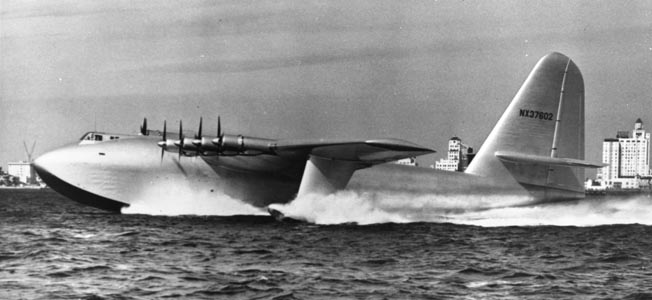As part of the 75 year anniversary of the flight of the Spruce Goose, we are taking a look at the Spruce Goose in a 3 part series. This is the third and final article in the series, which will discusses the history of the 1947 flight and taxi tests. Make sure to check out the first article in the series about the development of the Spruce Goose after learning more about the maiden flight.
Maiden Flight
During the Senate inquiry into the development and funding of H4, which Hughes had personally testified he would leave the country if it weren’t a success, Hughes returned to California to personally run taxi tests on the H-4.
For the maiden flight, it was none other than Howard Hughes himself at the controls of the Spruce Goose. As the Spruce Goose were to undergoing trials, on November 2, 1947, the taxi tests began with Hughes at the controls and a crew of 21 people to help fly the Goose, 7 industry representatives, and 7 members of the press. The crew of 21 included 1 copilot, 2 flight engineers, 16 mechanics, and 2 other flight crew members. During the taxi tests and flight, 8 of the 16 mechanics stood with fire extinguishers behind the engines, 1 mechanic for each engine. Note that there was not a fire suppression system built for the plane, so these mechanics had to manually perform this duty for the engines with cotton in their ears.
After the first two taxi runs, 4 reporters left to file stories while the remaining press stayed for the final test run of the day. On this final test run, the Goose started picking up speed on the channel facing Cabrillo Beach, and lifted off, remaining airborne for 26 seconds at 70 ft off the water at a speed of 135 miles per hour for about one mile. It is worth noting that flying at this altitude, the aircraft still experienced ground effect. Nevertheless, the brief flight proved to detractors that Hughes masterpiece was flight-worthy, thus vindicating the use of government funds that the US Senate was investigating.
It was Howard Hughes himself who told the flight engineer to lower the flaps, which led to the Spruce Goose to fly.
Therefore, there had to be engineers stationed behind each and every engine with fire extinguishers to put out any potential fires. With a flying boat made of wood, the last thing that is desired is for the engines to catch fire and that fire to spread and engulf the entire structure.
If you take a look in the belly of the plane towards the tail, the fire suppression system that was built into the plane was added in later, to prevent the wooden plane from combusting.
Moreover, to start the 8 engines, one would start a generator with a Ford Trimotor Engine inside of it, which would provide enough power to start the main engines. These 8 engines did have the ability to rotate clockwise and counter clockwise to allow for the plane to reverse course on the water when leaving harbor.
https://warfarehistorynetwork.com/2018/12/31/the-first-and-last-flight-of-the-spruce-goose/
Make sure to check in next week for the final chapter in the story, the post-flight history of the Spruce Goose. Please feel free to provide a comment. to let us know how we’re doing or if you have suggestions for future topics or questions. Plus, make sure to follow us on Twitter and Instagram to stay up to date on future stories such as this.

Be the first to comment on "Spruce Goose: Taking Flight In 1947"